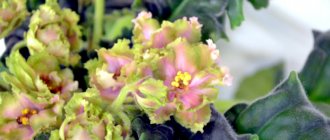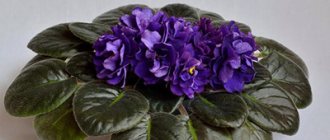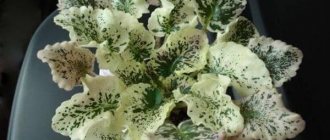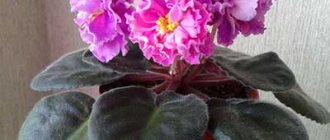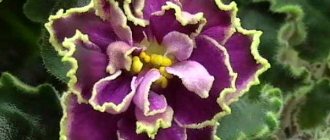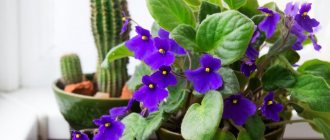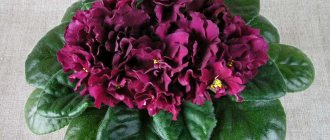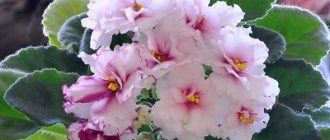Creating comfort in the home is an integral part of a woman’s task. Indoor flowers bring harmony to the home interior. Violet Your Majesty will not only decorate your home environment, but will also bring harmony and tenderness to the family hearth.
Unsurpassed colors and petal shapes have been created. They grow from gorgeous large specimens to mini-species, this is demonstrated by magnificent photos. Violet Your Majesty is that unique flower that blooms for a long time and pleases the eyes of others.
Even beginners can grow gorgeous living bouquets on their windowsill.
Botanical characteristics of violet
The plant is ideal for the home. With its delicate inflorescences of rainbow shades, it can charm almost the whole year.
Violet is a perennial plant. The oval-shaped leaves with uneven edges are collected in a rosette. Leaf color varies from light to dark green. The inflorescences are small with a diameter of 2 to 4 cm, of different shades.
There are a huge number of different selections and varieties of this beautiful popular plant. One of the most popular species are violets from the breeder Makuni. This group of Saintpaulias is named after him.
Violets Your Majesty Makuni are distinguished by large double inflorescences and have a large number of species.
Among the Makuni group, you should pay attention to certain varieties of violets:
- “Winter is smiling” - semi-double pink buds enchant the eye, and the petals look like delicate lace.
- “Forest Magic” - a bright and lush decoration of pink inflorescences is complemented by a refined white border.
- “The Swan Princess” amazes with its white buds and velvety petals. It is impossible not to fall in love with the violet Your Majesty, a photo and description of which are given on this page.
When looking at a flower pot, the illusion of a noble snow-white bird floating on green waves is created.
Briefly about breeders
The names of Boris Mikhailovich and Tatyana Nikolaevna Makuni are known to all connoisseurs of violets. Having started the Saintpaulia breeding activity in 1962, the Makunis, in a relatively short period of time, managed to obtain magnificent hybrids with a variety of colors and original flower shapes. The first domestic terry Saintpaulia “Natalie” was bred by the Makuni couple.
REFERENCE. In 1995, at an exhibition in Seattle, violets of the Makuni selection were so popular that a “Russian Superstar” sign was displayed next to them.
Each resulting variety has a unique name . The couple loved to give their works titles that had some meaning attached to them. Some Saintpaulias received names associated with family stories, such as “Blakha-fly”, “I won’t give it to anyone!”, “In memory of Tanya Makuni”. There are about 300 varieties of Saintpaulia bred by Makuni, many of which have received awards at domestic and foreign exhibitions.
In their work, breeders skillfully used dominant traits in seed propagation. The Makuni couple not only engaged in selection, but also kept detailed records of their work. This allowed them to highlight promising directions and cut off dead-end crossing lines. Breeders published printed works describing new varieties, propagation and care of violets.
For example, in one of the articles, the authors proposed options for soil mixtures for Saintpaulia , which they tested in practice. The book “Saintpaulia” by Makuni and Klevenskaya, which includes a description of botanical research and practical advice on growing and caring for plants, is now one of the most authoritative publications in this field.
Experts note that Boris Mikhailovich and Tatyana Nikolaevna laid the foundations of the Russian breeding school of Uzambara violets.
In 2005, at an exhibition dedicated to the 75th anniversary of B.M. Makuni, a prize named after him was established for the best domestic breeders.
Plant care
Violet does not require a lot of attention. You just have to follow the basic rules that your Highness the violet requires.
- The flower pot should be small, 5-7 cm in diameter, for young rosettes. For a large crown, 12 cm is suitable.
- A new pot should be doused with boiling water and vinegar, which will help avoid troubles in the future.
- The larger the pot, the more expanded clay or other drainage required.
- The soil needs to be loose and well permeable to water. There are various fertilizer admixtures. You can buy a ready-made earthen mixture for violets.
- Feeding is carried out annually, in spring or summer. The plant can be fed with mullein, bird droppings with vitriol, or a ready-made organic mixture.
- Watering is carried out regularly and moderately. The soil should be slightly moist. Excess moisture or drying out leads to disease and death of the flower.
- Violets love showers. The ground is covered during the procedure, and excess moisture is removed from the leaves using a paper napkin.
Violets, as a rule, delight with abundant blooms all year round. Experts say that plants need rest. Preferably in winter. To do this, cut off the flower stalks within 3 months.
A magnificent flower needs lighting, but does not tolerate exposure to direct sunlight and drafts.
Description of the species
Botanists call the horned violet Viola cornuta. This is a perennial plant with branched stems that form cushions. The viola is native to the mountainous regions of France and Spain. Depending on the variety, the height of the bushes is 10-30 cm. The leaves are dark green, simple, pointed at the ends. Their length is about 4 cm. Thanks to the creeping root, the plants quickly form a carpet. Its flowers have a small diameter - 3-5 cm. They are solitary, each with its own long petiole. In the middle of the flower there is a yellow or orange eye. Up to 60 fragrant flowers bloom on a bush at the same time.
Information. The horned violet got its name from the elongated growth behind the flower - the spur.
The plant does not require special care; it grows in loose soils with an acidity of pH 6.8-7.2. It requires moderate watering and good drainage. Flowering occurs from spring to autumn. The most abundant is in the first half of summer. In August, the number of peduncles and the size of the buds decrease. The horned violet is resistant to frost; in central Russia it remains in the ground for the winter.
Advice. In winters with little snow, cover the viola bushes with sawdust or spruce branches. This will help them survive the cold.
The optimal temperature for plant development is 16-19°C; in the spring they come to life when the temperature warms to 8°C. Before wintering, the flower stalks are removed, and the leaf rosette is trimmed every two to three years. In one place, viola blooms well for up to 5 years.
Violet propagation
Reproduction is best done in the spring during the active growing season.
Violet Your Majesty reproduces easily, in several ways:
- leaves;
- seeds;
- children;
- stepchildren.
The simplest and most common methods include propagation by leaves and stepsons.
Select healthy leaves and place them in a small container of water. The leaf is immersed in water no more than 1 cm. This level must be maintained until rooting. It is recommended to add activated carbon to the container.
After 30-40 days, the cuttings should produce roots. After this, the leaves are transplanted into a small pot. It is better to secure the leaf with a stick and cover it with polyethylene. After 2 weeks, the cover is removed - and in front of you is an independent flower.
Often several root rosettes form in one pot. When replanting plants, they should be separated. An independent flower is formed from each individual rosette.
Common varieties of horned violet
Breeders are actively engaged in crossing and breeding new varieties of Viola cornuta. Many seed producers have divided hybrid forms into two groups:
- Cornuta - includes several variety series, among which Velor (10 colors) and Princess (7 colors) are popular.
- Viola x hybrida - the plants have a complex hybrid origin, but the basis is Viola cornuta. The most famous variety series: Sorbet (20 shades), Penny (15 shades).
Fans of perennial violets can choose single-color varieties (white, cream, blue), as well as two or three colors. When growing hybrids, you should remember that they tolerate frost less well. You should take care of shelter for the winter. Some varieties are biennials.
Viola "Molly Sanderson"
The original colors of the perennial will appeal to lovers of exotics. The flowers are black or purple with a yellow center. The bushes are low, up to 15 cm, spreading. The leaves are green and shiny. The variety is resistant to wintering; light shelter is sufficient. Used for planting in rock gardens, rock gardens, and mixborders. The beginning of flowering is April. Prefers shaded areas.
Horned violet "Rebecca"
This variety is valued for its abundant and long flowering. Grows up to 15 cm. Used for planting near coniferous and deciduous shrubs. As it grows, a lush mat with many leaves and flowers is formed. The color of the petals is light yellow with purple strokes along the edges. Flowering from June until the first frost. In summer it requires watering.
Viola "Foxbrook Cream"
A distinctive feature of the variety is the snow-white petals of violets. It is perfect for decorating the foreground of borders and flower beds. The perennial grows in partial shade and in open areas. Leaves are not cut off for the winter. Flowering from May to September.
Variety "Boughton Blue"
The bushes grow only up to 10 cm, but the pale blue flowers delight with beauty from March until frost. An unpretentious perennial suitable for planting in pots. Prefers light, moist soil.
Violet Viola Columbine
The stems of the creeping plant form turf up to 20 cm high. The leaves are green, oblong, with large teeth. Numerous flowers are variegated in color; their petals combine white, purple and blue. The plant needs loose, fertile soil. Flowering continues from May to October. In winters with little snow, it is recommended to cover with spruce branches.
Diseases of flowers
Violets are quite resistant to various diseases.
If the leaves of the plant become limp and dull, you need to carefully examine the flower. In particular, the root system. Rotten roots are immediately removed, and the root is completely washed with a weak vinegar solution. Rinse the pot thoroughly and transplant the reanimated violet into fresh soil.
The presence of brown spots on the foliage indicates that the flower has been exposed to sunlight for a long time. Your Highness, the photo below clearly shows violet diseases.
The plant must be moved to a dark place. Dull leaves will regain their natural color. Injured leaves can be gradually removed.
Violet SM-Old Arbat
Saintpaulia Moreva Old Arbat.
A very beautiful seedling by Konstantin Morev. Socket :
The leaves are on short, rather thin cuttings, evenly distributed around the bush. The shape is heart-shaped , with small teeth along the edge, light green in color.
Flowers on strong peduncles:
- Several pieces each;
- Very big;
- Up to 6-7 cm;
- Forms a beautiful hat.
The shape of the flowers is simple and semi-double, the petals may not even be separated from each other , there is a pronounced corrugation along the edge. The color is violet-pink, with a slight darkening along the edge and a pencil violet-blue border.
Features of care
SM-Old Arbat care requires the use of classical methods of caring for Saintpaulias:
- The lighting is bright without direct sunlight;
- Moderate watering in the pan or under the leaves (reacts well to wick);
- Regular feeding - through watering;
- Replant as needed;
- Regular removal of aging parts of the plant.
It reproduces well, and the repeatability has been tested by gardeners, and the result is very good .
Reviews
The flowers are simply incomparable, the size, color and border simply fascinate me.”
The rosette itself is beautiful and blooms beautifully. I adore this beauty and recommend it to everyone, despite the fact that it is only a seedling.”
Pruning violets
Pruning is necessary for the plant. It is usually done in the spring, in the following cases:
- for rejuvenation, thus stimulating the formation of the root system;
- for abundant flowering;
- when old leaves die.
Violets, Your Majesty, will not only decorate the room, but will also purify the air and fill it with essential oils and pleasant aromas.
According to experts, violets have a positive aura. The aroma of flowers restores nervous tension, restores heart rate and has a beneficial effect on the immune system.
Violet SM-Smoke Above Water
Mysterious violet Smoke On The Water.
An excellent representative of the genus of hybrid Saintpaulias , another unrecognized Morev seedling variety.
The flowers are very unusual, semi-double with unusually thin petals that are corrugated only at the tips. The color is also quite unusual:
- The blue petals at the base fade smoothly into blue;
- And the edges and fringe are gray-green.
The rosette is slightly spreading through elongated and thin leaf stalks. The leaves are round with pronounced teeth along the edge. The color of the leaves is dark green with a pronounced network of veins.
During propagation, characteristics are often transferred, but among the reviews and data on the seedling, there is no exact information about what sports are.
Features of care
The variety does not require any special conditions. Even in good lighting:
- The sheets stretch;
- The rosette is not formed symmetrically;
- Peduncles are also prone to elongation.
Watering should not be too abundant, and it is also not recommended to use the wick type of watering; it promotes even greater elongation of cuttings and flower stalks.
It is recommended to feed SM-Smoke over water well, because a lack of minerals and nutrients leads to a deterioration in the appearance of the outlet.
Reviews
For now he lives with me, but I’ll try to change the conditions.”
Under my lamps, the rosette looks pretty decent and doesn’t pull the leaves too much, but the peduncles are a bit long.”


